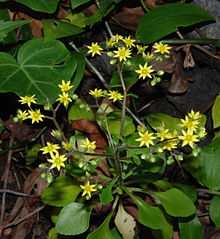Aichryson
| Aichryson | |
|---|---|
 | |
| Aichryson punctatum | |
| Scientific classification | |
| Kingdom: | Plantae |
| (unranked): | Angiosperms |
| (unranked): | Eudicots |
| (unranked): | Core eudicots |
| Order: | Saxifragales |
| Family: | Crassulaceae |
| Genus: | Aichryson Webb & Berthel. |
| Species | |
|
About 15; see text | |
Aichryson is a genus of about 15 species of succulent, subtropical plants, mostly native to the Canary Islands, with a few in the Azores, Madeira and Morocco, and one in Portugal.
The species of Aichryson are not frost-resistant. They are related to Sempervivum, Jovibarba, Greenovia, Aeonium and Monanthes, readily seen in their similar flowers.
Relationships
Recent phylogenentic studies of Crassulaceae indicate that Aichryson is closely related to Monanthes and Aeonium (both genera are also largely endemic to the Canary Islands). Two other genera of Crassulaceae that have many-parted (polymerous) flowers (Sempervivum and Jovibarba) are not closely related to the three Canary Island genera.[1][2][3][4]
On the Canary Islands, the center of species diversity seems to be the island of La Palma Relationships within Aichryson were investigated by Fairfield et al. (2004) [Plant Systematics and Evolution248: 71-83]. They found that the five subspecies of A. pachycaulon were not each other's closest relatives (monophyletic) and additional species may need to be erected after additional study.
Species
- Aichryson bethencourtianum
- Aichryson bollei
- Aichryson divaricatum
- Aichryson laxum
- Aichryson palmense
- Aichryson porphyrogennetos
- Aichryson tortuosum (Gouty Houseleek)
- Aichryson villosum
Other species recognized by Nyffeler in Eggli 2004 are:
- Aichryson brevipetalum
- Aichryson dumosum
- Aichryson pachycaulon (five subspecies have been recognized)
- Aichryson parlatorei
- Aichryson punctatum
A recently named species is:
- Aichryson bitumosum